|
May 1955 Popular Electronics
 Table
of Contents Table
of Contents
Wax nostalgic about and learn from the history of early electronics. See articles
from
Popular Electronics,
published October 1954 - April 1985. All copyrights are hereby acknowledged.
|
Bill (William) Winter served as the editor of the Academy of Model Aeronautics'
(AMA's) American Modeler and American Aircraft Modeler magazines
from 1966 through 1974, but his efforts to promote all form of modeling - airplanes,
helicopters, cars, boats, trains, and rockets - covered many decades. His first
recorded article, "Building the Famous Udet Flamingo," (co-authored by Walter McBride),
was published in the March 1935 issue of Universal Model Airplane News
magazine. His 264th, "The Soft Touch," appeared in
Model Aviation (the latest incarnation
of the AMA's flagship magazine) in 1996. This article entitled "The Boom in R/C
Boats" appeared in a 1955 edition of
Popular Electronics magazine which, during the early years of its existence
devoted quite a bit of print space to radio control airplanes, boats and cars. As
with all things electronics, a huge surge in consumer interest was occurring with
over-the-air communications.
See also "The Boom in R/C
Boats - Part 2," June 1955 Popular Electronics
The Boom in R/C Boats
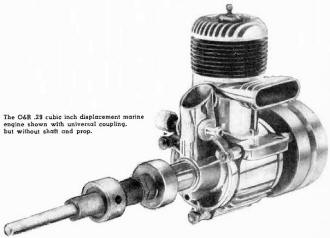
The O&R .29 cubic inch displacement marine engine shown with
universal coupling, but without shaft and prop.
By William Winter
Editor, "Model Airplane News"
Whether you build a semi-scale river boat or a sleek 36-inch motor cruiser, there's
fun in R/C boats.
What do the words "radio-controlled model boats" mean to you? A steam-puffing
tug as big as the kitchen table? A plunging PT boat, flags waving, turrets revolving?
Well, you're only partly right. The R/C hobbyist is building every conceivable type
of boat by the tens, if not hundreds, of thousands.
There's been a stampede to the hobby shops. One manufacturer had to suspend advertising
of his deluxe boat because he had fallen so far behind the demand. According to
a recent survey, 45 percent of the people who read the model airplane magazines
now also build boats. Tune a communications receiver to 27.255 mc. and you'll probably
pick up some fascinating pulsing.
Reasons aplenty exist for this frenzied marine activity. To begin with, it's
one of the inevitable but unexpected results of the establishment by the FCC of
the Citizens Band frequencies of 27.255 and 465 mc. Then again, radio-controlling
a boat is easier and more convenient than flying a plane by R/C. Boats don't fly
away.
You can sail a boat on a couple of inches of water, in swimming pools and ponds.
You can take the things on vacation and have fun while the kiddies splash about.
Equipment-wise, weight isn't the critical factor for boats that it is in aircraft.
Receivers don't have to be too sensitive, for the range required is not great. Equipment
that gives trouble in the air is adequate on the water. Big batteries can be used
to insure long life and reliability.

Typical .049 cubic inch gas-powered outboard engine for model
boats. It clamps onto the boat and steers just like its grownup counterpart. Made
by Allyn.
For the benefit of those who have not yet used the Citizens Band, the popular
frequency of 27.255 mc. is examination-free, but not license-free. All you have
to do, however, is to fill out and return to the FCC in Washington, D.C., the Form
505 that comes with the transmitter, if you buy a commercial one, or which you can
obtain from the FCC if you build your equipment. Other readers, no doubt, are hams,
who prefer to build their own equipment and who can, and usually do, operate on
other frequencies to avoid the Sunday jam session on the Citizens Band at the park.
Popular Electronics has published construction articles on transmitters, receivers,
and control systems that can be used for model boats. Almost anything has been described
somewhere so that a little research will strike pay dirt. Advertised parts kits
cover everything electronic that has been published in the model field. Prefabricated
boat construction sets to suit every taste and pocketbook are on the hobby dealers'
shelves.
The typical boat is controlled with the same type of equipment and by the same
methods as an airplane, although the marine field seems to offer greater flexibility
in the combinations of controls, power plants, and actuators. The choice of equipment
is directly affected by the size and type of boat. Usually the boat comes first
and everything else is tailored to fit.
While anyone can make a boat, it is desirable that the new builder have some
perspective on his project before he commits himself to construction. A speed boat
that wallows like a barge is the too-frequent result of a willy-nilly approach.
Boat size, power, and equipment should always be considered in combination.
Although it is possible to equip the smaller boat kits (15 to 16 inches in length)
with radio, it is better to choose a hull that measures 20 inches or more. Open
cockpit (amidships) affairs can be tough because the open area makes it difficult
to hide heavy batteries, etc., without affecting the boat's riding qualities. The
boat with an approximate hull length of 20 inches should use reduced power (.049
or "Half A ") or one of the smaller electric motors, depending on how fast you want
it to go. The Sterling "Chris Craft" (19 inches) is a good example of a boat that
would use a lightweight receiver, such as the Lorenz "two-tuber," and an airplane-weight
battery complement.
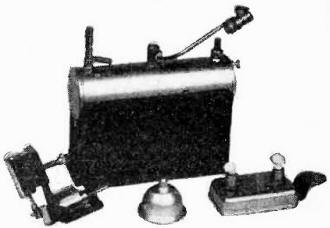
Model boat steam engine with boiler.
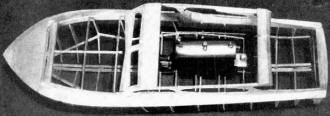
Steam engine and boiler installed in boat. This is the Allyson
engine.
Boats of 24 to 30 inches length will operate on .075, .09, .15, and .19 power,
depending on the size, weight, and desired speed. The Pittman electric motor, or
two electric motors in a twin-screw arrangement, can also be used.
Veteran boat modelers warn against overpowering a boat. Once the craft gets barreling
along, you may have to be fast on the control button, just as with an airplane.
This is especially true if the boat is being operated in cramped or crowded quarters,
where it has to be turned frequently to avoid banks, bulkheads, piles, other boats,
or just some joker in a row boat. Berkeley's 32 inch "Chris Craft" has only a Cameron
.09 for power. However, the boat is very light because of its formed plastic hull;
a big engine would take it across a pond in nothing flat. Select the powerplant
size with the site in mind.
Because so many boat kits exist, the choice can be confusing. It is possible,
however, to mention some widely used models. Sterling Models, 153-34 N. Hancock
St., Philadelphia 22, Pa., currently lists about a dozen, of which five are particularly
well suited for R/C. These are the "Chris Craft Cruiser" (28 inches), "Chris Craft
Catalina" (31 1/4 inches), "Harco 40 Deluxe" (27 1/2 inches), the "Chris Craft Monterey"
(outboard cabin, 21 inches), and the "Chris Craft Motor Yacht" (40 inches).
Dumas Products Inc., Airport Rd., Phoenix, Ariz., lists approximately 20 boats,
practically all of which are big enough for practical R/C work. The biggest is the
"Chris Craft Sport Fisherman" (35 inches), closely followed by the "Chris Craft
Challenger" (33 1/2 inches), and the "Chris Craft Commander" (33 inches). The "Commander"
and "Challenger" weigh approximately 2 1/2 pounds, less radio gear and batteries
if electric drive is used. Gross "tonnage" would be 4 1/2 to 5 pounds.
Berkeley Model Supplies, West Hempstead, N. Y., has a number of boats, with the
32-inch long "Chris Craft Cruiser" heading the list. Also available are the "Sea
Bird," a 28-inch racing boat, and an outboard "Chris Craft Express Cruiser," 18
inches long.
Another worthy boat is the "Wavemaster," by Telecommander (American Telasco.,
Huntington Station, N. Y.), a 34-inch job that also can take a beating. It is made
of hard wood and weighs 7 pounds empty. Constructo, 1186 Broadway, New York, N.
Y., has a completely assembled 36-inch "Harco Cabin Cruiser," for about twice the
price of a comparable kit.
Original designs, preferably based upon existing real boats, should not be overlooked.
Why not, for instance, a steam-powered tug, tramp steamer, or some humble but realistic
harbor craft? From time to time such designs are published by various magazines.
You can pick up three views from a boating magazine or from boat manufacturers'
literature. These views can be enlarged by photostating or with the aid of drafting
tools. A carved balsa-wood hull mock-up can be sawed into the required number of
sections. The end of each hull slice provides a perfect bulkhead pattern. To save
money and blisters, make the hull to a smaller scale and then photostat up the resulting
bulkhead patterns.
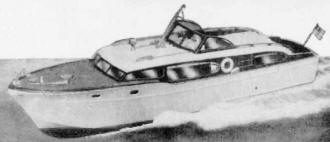
The largest R/C boat in American hobby shops is the "ChrisCraft
Corvette" shown here. It will carry 75 pounds.
For durability use mahogany plywood for siding - 1/16 inch thickness is plenty.
Covering the balsa-wood bow, if not entire hull, with Fiberglas makes it almost
indestructible. Fiberglas patching kits can be obtained at boat yards, some hardware
stores, and hobby shops.
Power Plants
Until recently, there were very few true marine model power plants. Nine out
of ten boats ran on converted model airplane motors, which tend to overheat under
load, especially when mounted inside the cabin. Marine conversion of these power
plants usually was left to the builder who had to pick up, piecemeal, his flywheel,
stuffing box, coupling, shaft, propeller, etc. Today, marine engines exist for any
model boat and electric drive has proved eminently satisfactory. Though hardware
is found easily, it is still true that no one knows much about the precise propeller
that is best for a boat, considering the power plants you may choose. This means
that boats usually need to be "shaken down" with various for their design, workmanship,
and performance. Atwood also has a water-jacketed .049 for inboard use, and an air-cooled
version of the same engine. Allyn recently introduced a couple inboard .049's.
Steam power plant, while not extensively used, nevertheless are readily available.
For those who value realism they are tops. A typical engine has a single-cylinder
oscillating design, using a "pot" boiler and a spirit wick lamp. Allyson Co., Box
115, Brevoort Station, Brooklyn 16, N. Y., has such an engine, as well as more advanced
types. Boucher-Lewis, 36 E. 12th St., New "props" tried to give the desired running
speed and turning characteristics.
In the bigger engines, the Cheminol Corp. has for some years turned out the "O &
R Marine" .29, a high performance engine with matching hardware, beautifully designed
from coupling to propeller. This rugged engine has a front and rear bearing and
has the flywheel mounted to the rear, making it most accessible for starting.
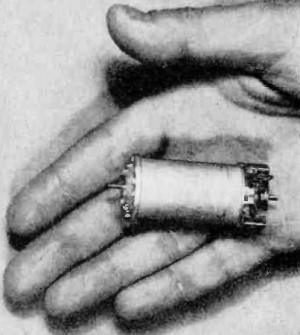
The midget-sized German Distler electric motor has a drain of
only 12 to 15 milliamperes at 4 1/2 volts. Ideal for R/C boats.
Cameron Precision Engineering Co. makes a jewel of an .09 inboard engine that
has no competition. It was designed for continuous running, great strength, good
cooling, high torque, and is protected against over "revving." Out of the water,
most boat engines will scream their lives away if excessively abused, as they exceed
20,000 rpm's under no load without difficulty. The Cameron is designed against this.
Although water cooling is provided, this engine is adequately finned for better
air cooling than some air-cooled engines.
Two firms, Allyn Sales Co. Inc. and Atwood Motors, make scale outboard engines
of .049 displacement that are remarkable May, 1955 York, has long been noted for
their realistic line of marine steam power plants of all types, patterned after
full -scale types. These are deluxe items.
Battery drain, the old bugaboo of electric drives, is no longer a worry, now
that high-torque, low drain, electric motors are in good supply. Probably the best
known is the Pittman "Panther" and "Super Panther." The "Super Panther" will turn
a 2-inch marine propeller at 1,700 rpm under load, at a drain of only 1.7 amperes
on six volts. When used with the Willard WT 6 wet cell storage batteries, a couple
of hours running time is assured. Two of these batteries can be connected in parallel
for long life when installed in the bigger boats and like car batteries, they can
be recharged. The German Distler electric motor, distributed by Polk's Model Craft
Hobbies, New York City, has the phenomenally low drain of only 12 to 15 milliamperes
on 4 1/2 volts. The magnetic field is inside the armature!
Other usable electric motors include the "Tiny Atom" by Wilson's of Cleveland,
Ohio, for 3, 4 1/2, and 6 volts. Wilson's has a famous gear train which can be used
as a speed reduction unit, or as a proportionate-type servo as specified on some
Sterling plans. Popular, especially on the West Coast where Pittman motors seem
hard to get, is the Japanese "K & O," with a built-in gear reduction.
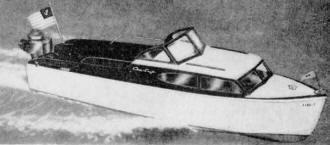
Typical outboard-type model boat controllable by radio. Its length
is twenty-one inches, which is close to the minimum for practical operations with
reliable radio.
Converted 12 -volt, "O"-gauge train engines may be operated off two WT 6 batteries
connected in series.
If it is smoke and noise you want, use the gas engine. Outboard types almost
certainly have to be gas, although hobby shops stock two scale-type, battery-powered
outboards, which could be used on small boats with a lightweight radio installation
and simple escapement. Electric drive has real advantages. It is clean and it works
by turning a switch. No fueling, attaching of booster leads, or cord pulling of
flywheels. Gas exhaust and spilled fuel require fuel proofing and constant cleaning.
The electric boat is always clean. Even the wet cells are spill proof.
(To be continued)
Posted October 12, 2019
|



